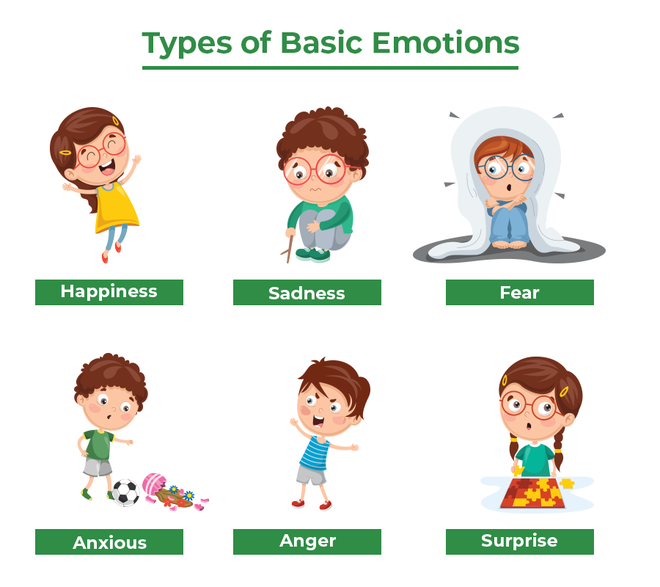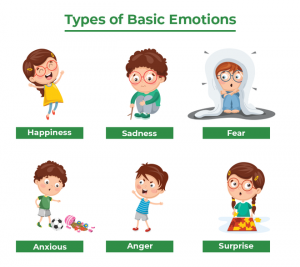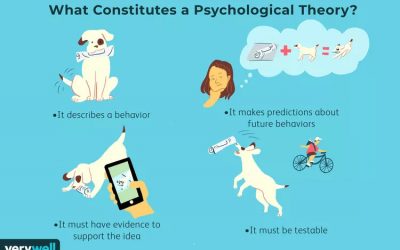
There are many different types of emotions that have an influence on how we live and interact with others. At times, it may seem like we are ruled by these emotions. The choices we make, the actions we take, and the perceptions we have are all influenced by the feelings we are experiencing at any given moment.
Psychologists have also tried to identify the different types of emotions that people experience. A few different theories have emerged to categorize and explain the emotions that people feel.
What Human Emotion Are You? Take the Quiz and Find Out
Emotions are a critical component of our daily lives and can often define the human experience. Take this free quiz to help you determine which emotion drives the way you experience the world and express your feelings.
Basic Emotions
During the 1970s, psychologist Paul Eckman identified six basic emotions that he suggested were universally experienced in all human cultures. The emotions he identified were happiness, sadness, disgust, fear, surprise, and anger. He later expanded his list of basic emotions to include such things as pride, shame, embarrassment, and excitement.
 Verywell / JR Bee
Verywell / JR Bee
Combining Emotions
Psychologist Robert Plutchik proposed a “wheel of emotions” that worked something like the color wheel. Emotions can be combined to form different feelings, much like colors can be mixed to create other shades.
According to this theory, the more basic emotions act something like building blocks. More complex, sometimes mixed emotions, are blendings of these more basic ones. For example, basic emotions such as joy and trust can be combined to create love.
A 2017 study suggests that there are far more basic emotions than previously believed.1 In the study published in Proceedings of National Academy of Sciences, researchers identified 27 different categories of emotion. Rather than being entirely distinct, however, the researchers found that people experience these emotions along a gradient.
Let’s take a closer look at some of the basic types of emotions and explore their impact on human behavior.
Happiness
Of all the different types of emotions, happiness tends to be the one that people strive for the most. Happiness is often defined as a pleasant emotional state that is characterized by feelings of contentment, joy, gratification, satisfaction, and well-being.
Research on happiness has increased significantly since the 1960s within a number of disciplines, including the branch of psychology known as positive psychology. This type of emotion is sometimes expressed through:
- Facial expressions: such as smiling
- Body language: such as a relaxed stance
- Tone of voice: such as an upbeat, pleasant way of speaking
While happiness is considered one of the basic human emotions, the things we think will create happiness tend to be heavily influenced by culture. For example, pop culture influences tend to emphasize that attaining certain things, such as buying a home or having a high-paying job, will result in happiness.
The realities of what actually contributes to happiness are often much more complex and more highly individualized.2 People have long believed that happiness and health are connected, and research has supported the idea that happiness can play a role in both physical and mental health.
Happiness has been linked to a variety of outcomes including increased longevity and greater marital satisfaction.3 Conversely, unhappiness has been linked to a variety of poor health outcomes and challenges in relationships.
Stress, anxiety, depression, and loneliness, for example, have been linked to things such as lowered immunity, increased inflammation, and decreased life expectancy.4
Sadness
Sadness is another type of emotion often defined as a transient emotional state characterized by feelings of disappointment, grief, hopelessness, disinterest, and dampened mood.
Like other emotions, sadness is something that all people experience from time to time. In some cases, people can experience prolonged and severe periods of sadness that can turn into depression. Sadness can be expressed in a number of ways, including:
- Crying
- Dampened mood
- Lethargy
- Quietness
- Withdrawal from others
The type and severity of sadness can vary depending upon the root cause, and how people cope with such feelings can also differ.
Sadness can often lead people to engage in coping mechanisms such as avoiding other people, self-medicating, and ruminating on negative thoughts. Such behaviors can actually exacerbate feelings of sadness and prolong the duration of the emotion.
Fear
Fear is a powerful emotion that can also play an important role in survival. When you face some sort of danger and experience fear, you go through what is known as the fight or flight response.
Your muscles become tense, your heart rate and respiration increase, and your mind becomes more alert, priming your body to either run from the danger or stand and fight.5
This response helps ensure that you are prepared to deal with threats in your environment effectively. Expressions of this type of emotion can include:
- Facial expressions: such as widening the eyes and pulling back the chin
- Body language: attempts to hide or flee from the threat
- Physiological reactions: such as rapid breathing and heartbeat
Of course, not everyone experiences fear in the same way. Some people may be more sensitive to fear, and certain situations or objects may be more likely to trigger this emotion.
Fear is the emotional response to an immediate threat. We can also develop a similar reaction to anticipated threats or even our thoughts about potential dangers, and this is what we generally think of as anxiety. Social anxiety, for example, involves an anticipated fear of social situations.
Some people, on the other hand, actually seek out fear-provoking situations. Extreme sports and other thrills can be fear-inducing, but some people seem to thrive and even enjoy such feelings.
Repeated exposure to a feared object or situation can lead to familiarity and acclimation, which can reduce feelings of fear and anxiety.6
This is the idea behind exposure therapy, in which people are gradually exposed to the things that frighten them in a controlled and safe manner. Eventually, feelings of fear begin to decrease.
Disgust
Disgust is another of the original six basic emotions described by Eckman. Disgust can be displayed in a number of ways including:
- Body language: turning away from the object of disgust
- Physical reactions: such as vomiting or retching
- Facial expressions: such as wrinkling the nose and curling the upper lip
This sense of revulsion can originate from a number of things, including an unpleasant taste, sight, or smell. Researchers believe that this emotion evolved as a reaction to foods that might be harmful or fatal.7 When people smell or taste foods that have gone bad, for example, disgust is a typical reaction.
Poor hygiene, infection, blood, rot, and death can also trigger a disgust response. This may be the body’s way of avoiding things that may carry transmittable diseases.7
People can also experience moral disgust when they observe others engaging in behaviors that they find distasteful, immoral, or evil.
Anger
Anger can be a particularly powerful emotion characterized by hostility, agitation, frustration, and antagonism toward others. Like fear, anger can affect the body’s fight-or-flight response.
When a threat generates feelings of anger, you may be inclined to fend off the danger and protect yourself. Anger is often displayed through:
- Facial expressions: such as frowning or glaring
- Body language: such as taking a strong stance or turning away
- Tone of voice: such as speaking gruffly or yelling
- Physiological responses: such as sweating or turning red
- Aggressive behaviors: such as hitting, kicking, or throwing objects
While anger is often thought of as a negative emotion, it can sometimes be a good thing. It can be constructive in helping clarify your needs in a relationship, and it can also motivate you to take action and find solutions to things that are bothering you.
However, anger can become a problem when it is excessive or expressed in unhealthy, dangerous, or harmful ways. Uncontrolled anger can quickly turn to aggression, abuse, or violence.
This type of emotion can have both mental and physical consequences. Unchecked anger can make it difficult to make rational decisions and can even have an impact on your physical health.8
Anger has been linked to coronary heart diseases and diabetes. It has also been linked to behaviors that pose health risks such as aggressive driving, alcohol consumption, and smoking.
Surprise
Surprise is another of Eckman’s six basic types of human emotions. It is usually quite brief and characterized by a physiological startle response following something unexpected.
This type of emotion can be positive, negative, or neutral. An unpleasant surprise, for example, might involve someone jumping out from behind a tree and scaring you as you walk to your car at night.
An example of a pleasant surprise would be arriving home to find that your closest friends have gathered to celebrate your birthday. Surprise is often characterized by:
- Facial expressions: such as raising the brows, widening the eyes, and opening the mouth
- Physical responses: such as jumping back
- Verbal reactions: such as yelling, screaming, or gasping
Surprise is another type of emotion that can trigger the fight or flight response. When startled, people may experience a burst of adrenaline that helps prepare the body to either fight or flee.9
Surprise can have important effects on human behavior. For example, research has shown that people tend to disproportionately notice surprising events.
This is why surprising and unusual events in the news tend to stand out in memory more than others. Research has also found that people tend to be more swayed by surprising arguments and learn more from surprising information.
Other Types of Emotions
The six basic emotions described by Eckman are just a portion of the many different types of emotions that people are capable of experiencing. Eckman’s theory suggests that these core emotions are universal throughout cultures all over the world.
However, other theories and new research continue to explore the many different types of emotions and how they are classified. Eckman later added a number of other emotions to his list but suggested that, unlike his original six emotions, not all of these could necessarily be encoded through facial expressions. Some of the emotions he later identified included:
- Amusement
- Contempt
- Contentment
- Embarrassment
- Excitement
- Guilt
- Pride in achievement
- Relief
- Satisfaction
- Shame
Other Theories of Emotion
As with many concepts in psychology, not all theorists agree on how to classify emotions or what the basic emotions actually are. While Eckman’s theory is one of the best-known, other theorists have proposed their own ideas about what emotions make up the core of the human experience.10
For example, some researchers have suggested that there are only two or three basic emotions. Others have suggested that emotions exist in a hierarchy. Primary emotions such as love, joy, surprise, anger, and sadness can then be further broken down into secondary emotions. Love, for example, consists of secondary emotions, such as affection and longing.
These secondary emotions might then be broken down still further into what are known as tertiary emotions. The secondary emotion of affection includes tertiary emotions, such as liking, caring, compassion, and tenderness.
A more recent study suggests that there are at least 27 distinct emotions, all of which are highly interconnected.11 After analyzing the responses of more than 800 men to more than 2,000 video clips, researchers created an interactive map to demonstrate how these emotions are related to one another.
“We found that 27 distinct dimensions, not six, were necessary to account for the way hundreds of people reliably reported feeling in response to each video,” explained the senior researcher Dacher Keltner, faculty co-director of the Greater Good Science Center.
In other words, emotions are not states that occur in isolation. Instead, the study suggests that there are gradients of emotion and that these different feelings are deeply inter-related.
Alan Cowen, the study’s lead author and former doctoral student in neuroscience at UC Berkeley, suggests that better clarifying the nature of our emotions can help scientists, psychologists, and physicians learn more about how emotions underlie brain activity, behavior, and mood. By building a better understanding of these states, he hopes that researchers can develop improved treatments for psychiatric conditions.
Final Thoughts
Emotions play a critical role in how we live our lives, from influencing how we engage with others in our day to day lives to affecting the decisions we make. By understanding some of the different types of emotions, you can gain a deeper understanding of how these emotions are expressed and the impact they have on your behavior.
It is important to remember, however, that no emotion is an island. Instead, the many emotions you experience are nuanced and complex, working together to create the rich and varied fabric of your emotional life.






Aute mi ut suspendisse velit leo, vel risus ac. Amet dui dignissim fermentum malesuada auctor volutpat, vestibulum ipsum nulla.
Eu et tellus vestibulum taciti et sit, nunc enim ipsum donec aliquam vitae, per mauris, amet ultrices. Pellentesque amet proin ut vestibulum eleifend nam, wisi vel tellus pulvinar mi risus consectetuer, sed faucibus facilisi, accumsan nam.
Sed reprehenderit quam, non felis, erat cum a, gravida lorem a. Ultricies in pellentesque ipsum arcu ipsum ridiculus velit magna, ut a elit est. Ultricies metus arcu sed massa. Massa suspendisse lorem turpis ac.